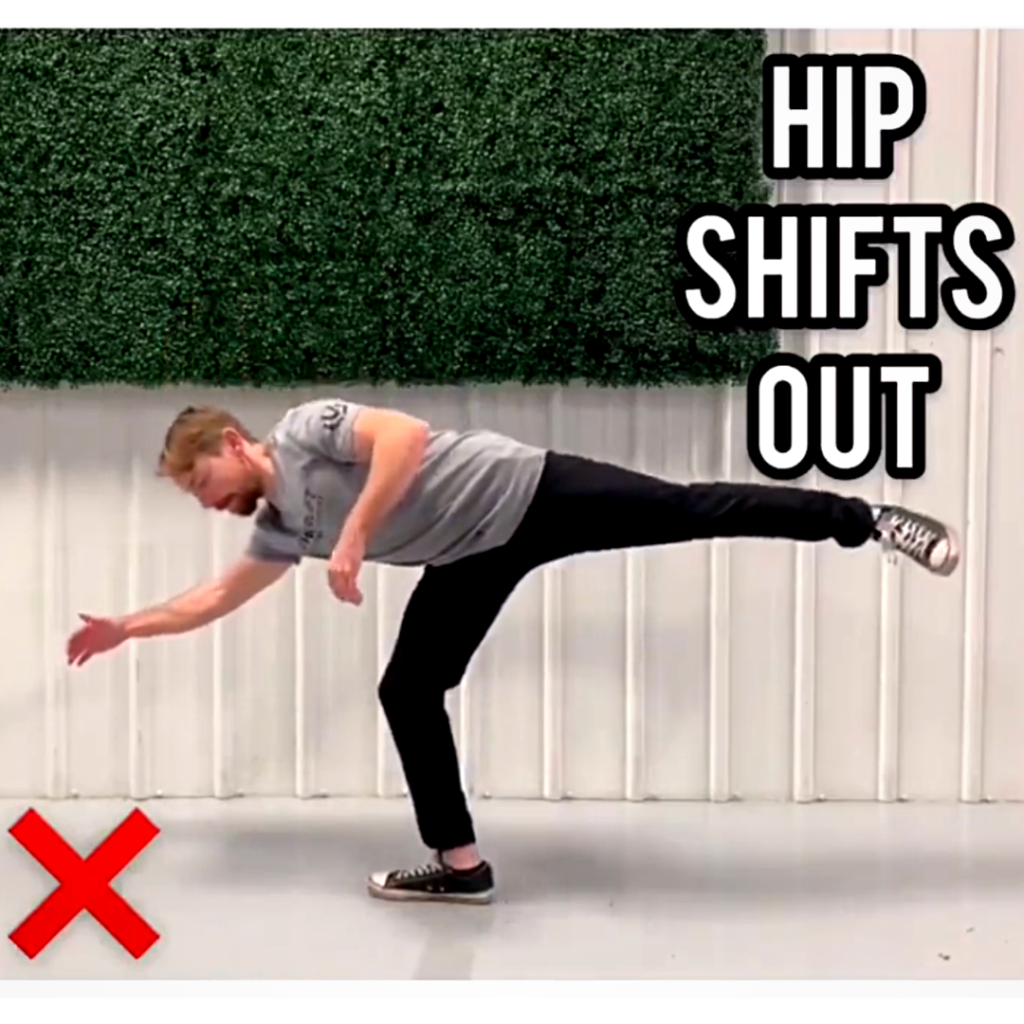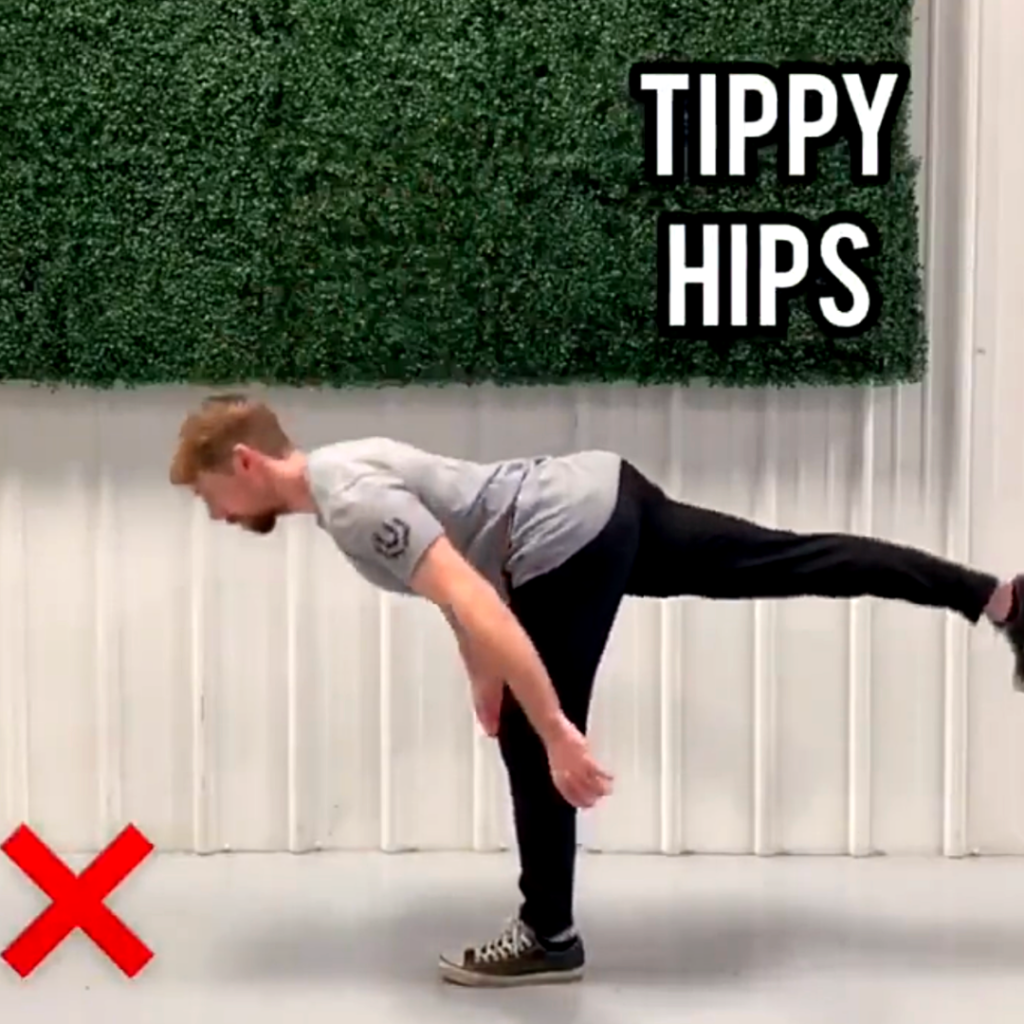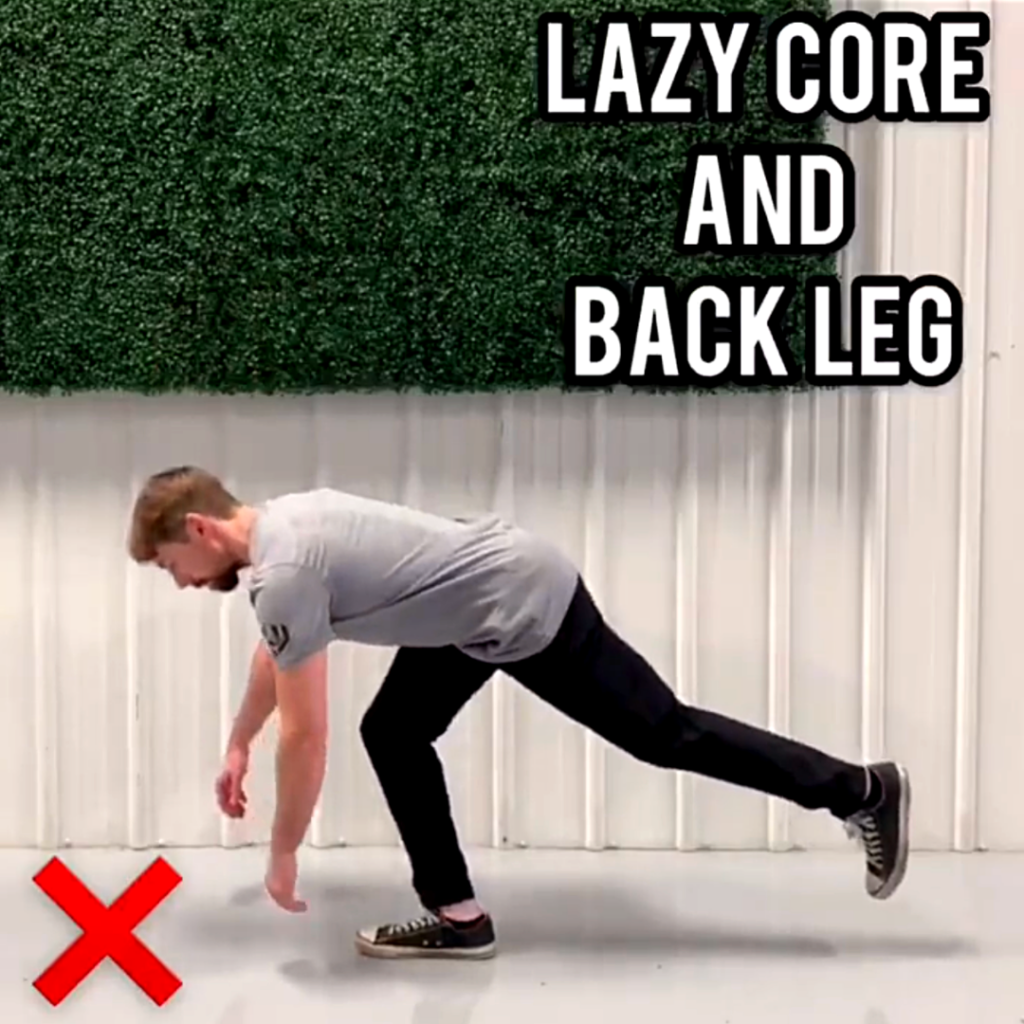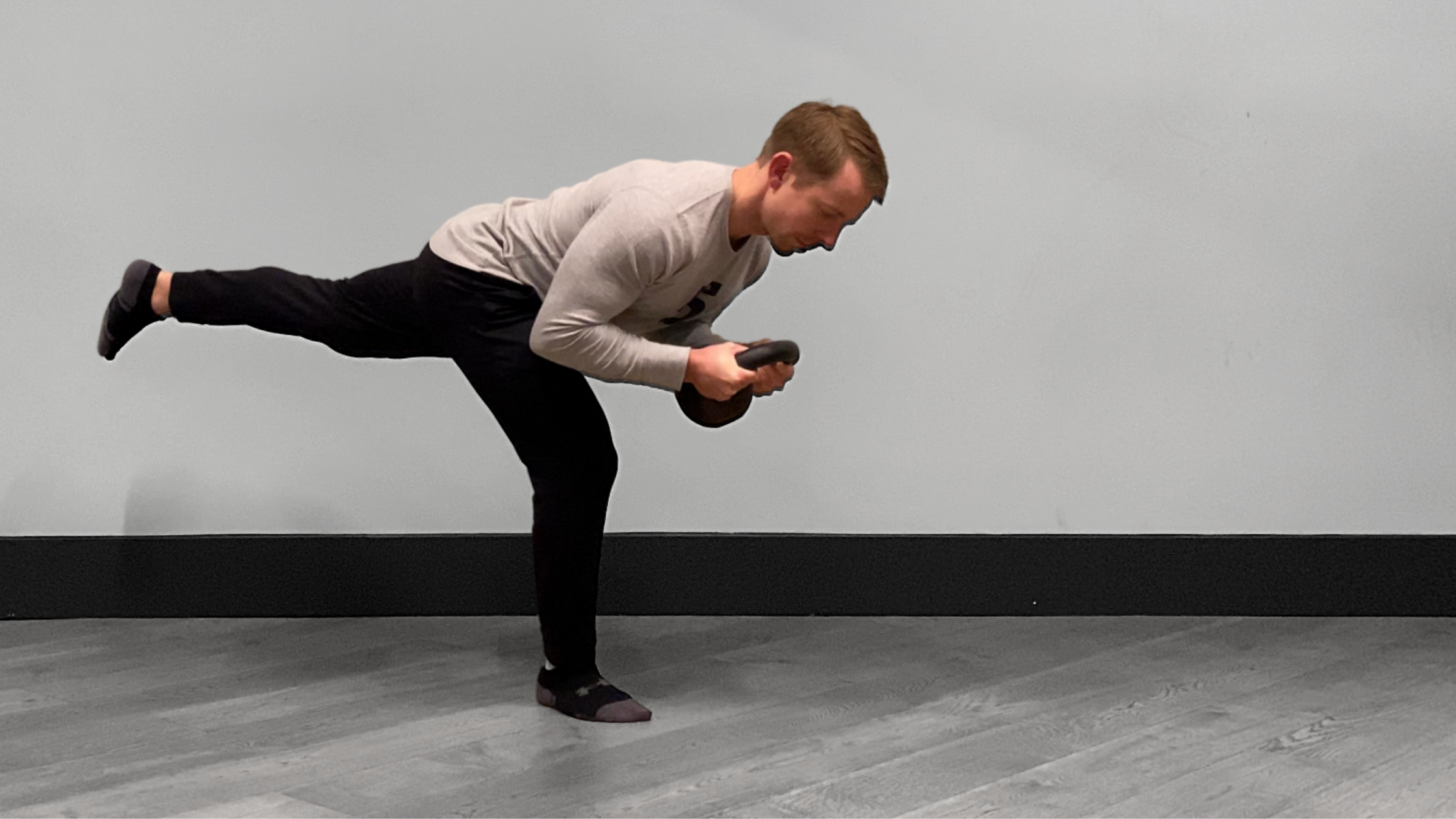The deadlift and all its variations develop strength in the posterior chain (glutes, hamstrings, back, and lats), and when performed on one leg, we stack up new levels of balance and athleticism without the need for complex agility drills. Keep reading to learn how to single-leg deadlift with proper form and some of my favorite SLDL progressions.
Want to follow along with the video version of this article?
Just push play!
I’m adamant about programming single-leg exercises, specifically the single-leg deadlift, for all my clients – from competitive powerlifters to fitness newbies.
Why?
Three reasons.
First – much of life happens on one leg.
(The fact that I’m writing this article just days after a skiing accident put my right foot in a cast makes me lol)
From climbing stairs to kicking soccer balls, your ability to control and express strength through one leg at a time is a key physical skill.
The single-leg deadlift is a great place to start.
Second – single-leg work will make your big lifts bigger.
Let me explain.
Traditional bilateral moves that use both legs equally (like barbell squats and deadlifts) are great for building absolute strength with heavy weights…
But they can easily hide underlying stability issues.
Subtract a limb, and true movement control is revealed.
Single-leg exercises allow you to find and fill those gaps in stability, mobility, and proprioception that could be holding you back from big gains.
With the deadlift, you want the hamstrings to fire equally, the hips to remain square, and the back to stay neutral.
Small asymmetries can grow into real problems down the line if not addressed.
When you make each side stronger independently, they’ll crush it when brought back together. Teamwork makes the dream work.
Third – single-leg exercises deliver a real metabolic hit to boost fat loss and work the lungs.
Single-leg deadlifts are just plain hard and inefficient. When your whole body is forced to work and coordinate to the max on every rep, time under tension increases, more calories are burned, and the heart rate spikes.
What is the single-leg deadlift?
The SLDL is a hip-hinge exercise, meaning the goal is to flex at the hips, push the butt back, and then extend the hips forward back to neutral.
It’s in the same family as the traditional deadlift, kettlebell swing, and hip thrust. With all these exercises, your goal is to move the torso around the fulcrum of the hip joint, not by bending the spine or squatting down with excessive knee bend.
As the name suggests, you’ll perform the hip hinge pattern on one leg while the other leg stays in strong hip extension the whole time. In other words – keep the floating leg straight and locked out, more or less in line with the spine.
Like most hip-hinge exercises, the single-leg deadlift targets the big muscles of the posterior chain – the hamstrings, glutes, and erectors. Because you’ll be standing on one leg, the calves and quads will also work extra hard to stabilize the knee.
When using weight, the SLDL can be performed in two general ways:
“Romanian deadlift” style (RDL) where the weight stays floating during the set.
Or the traditional dead-stop style where the weight rests momentarily on the floor between each rep.
Each version offers unique benefits.
The RDL version keeps the muscles under constant tension to support muscle building and endurance. The dead-stop SLDL is great for building “off the floor” strength and can generally be loaded heavier.
Single-leg deadlift vs. traditional deadlift
When loaded up with heavy weight, the traditional barbell deadlift is the king of the posterior-chain lifts.
Alas, heavy deadlifts aren’t appropriate for everybody all the time.
We’ve already covered many of the unique benefits the single-leg deadlift has to offer, but it bears repeating – the SLDL can fill the movement gaps created or exacerbated by traditional deadlifts and squats.
The SLDL really shines for those of us working out at home with minimal equipment and is highly effective with just a couple kettlebells or dumbbells. Plus, the bodyweight-only version can be quite challenging as well.
Bottom line – the traditional deadlift is your go-to for building maximal strength while the single-leg deadlift can serve as a top accessory exercise or even the primary hip-hinge exercise for minimalist trainees.
In either case, the SLDL represents a must-do pattern. Lucky for us, there are many variations of the SLDL so we can usually find options that are valuable for lifters of any skill level.
How to single-leg deadlift with proper form
To ensure you’re ready to safely tackle the SLDL, let’s hit a quick clearing test.
Simply stand on one leg and bring the opposite knee up as high as you can.
Really root through the foot and grip the ground with your toes. Don’t slouch on your hip joint but rather engage the quads, glutes, and abs to maintain a tall posture.
Keep the knee as high as you can without over-arching the back or tucking the tailbone.
When you can hold this position and intension for 10 seconds each side, you’re ready for for the SLDL!
Let’s start with the slider SLDL:
(You can do these in socks or use a Val Slide, furniture slider, or paper plate)
Post up on the tip toes of the unloaded leg and slide the foot back with stiff quads. Slowly increase the reach while staying balanced on the front foot.
When you feel a good hamstring stretch or you’re close to losing balance, squeeze the glutes and slide the leg forward back to standing.
Once you’re confident with the range of motion, you can slide the foot back, pause, raise the leg up in line with the spine, and stand.
For the next two drills, we’re going to use a foam roller to help you find stability and balance.
Stand a roller up vertically next to the floating leg and place the nearest hand on top, using it as a balance aid. Again, push the hips back and drive the back leg strong and straight.
As balance improves, move the roller farther away and apply less and less pressure until you’re barely balancing with one finger.
Now let’s use the roller to help create core stability and linkage between the upper body and lower body.
Place one end of the roller on the top of the floating foot. Palm the other end with the same side arm, keeping both limbs locked straight.
Start with a little kick forward before sweeping the leg back. Maintain light to moderate pressure through the roller to really challenge the full-body linkage. Sweep the leg forward and repeat.
Now for our first variation without assistance!
Clasp your hands behind your back, really pull the shoulders down and make a proud chest. Sweep the leg forward and back as before.
The second option here is to reach the arms long and forward while keeping the shoulders and hips squared off.
By this point, you should have a firm grasp on how to root through the floor, load the hamstrings, and keep the floating leg active which means we can begin to add extra load in the hands.
Start by holding a kettlebell or weight plate on the chest and perform the SLDL as usual.
For the sake of safety and stability, I like to reestablish ground contact with the floating foot on each rep. To help really engage the lats, you can move the weight down towards the bellybutton during the hip hinge, essentially creating an isometric row.
By starting with the weight held high around the upper body, you’re learning how to keep the core engaged and torso square which are important to keep in mind as we move to heavier weights with straight arms.
Now we’ll take a look at the most commonly seen variation – the contralateral single-leg RDL. Contralateral simply means the opposite arm and leg are loaded, so if you’re standing on the left foot, the weight is held in the right hand.
Begin by standing with both feet on the ground. Hold a dumbbell or kettlebell close by the floating leg. As the leg moves back, simply fill the space with the loaded arm.
Hinge back until your hand is somewhere around or just below the knee. Pause for a second, squeeze, and stand up.
Another variation to really wind up the hip is to push the weight across the midline towards the standing foot. This doesn’t mean to go deeper, just add a subtle inside turn with the hip and torso.
Here’s a bonus exercise to really challenge your stability in that hip hinge position – at your deepest range of motion or a bit higher, maintain your alignment and balance as you pass the kettlebell from one hand to the other. Try 3-5 passes each side and stand.
The next option is the traditional deadlift where the weight is lifted and returned to the ground on every rep. This one’s a bit more challenging because you’ll have to establish your single leg balance before lifting the weight.
Line up the weight just to the inside of your standing foot so you’ll be reaching straight down for it, not out and away. Perform the eccentric portion of the SLDL as usual, grab the handle, and slowly squeeze the weight off the floor.
Pause here for a few seconds to really own this bottom position and stay tight. Slowly stand up, and at the top, kickstand the leg to find balance and rest momentarily.
Keep the lats tight on the negative to prevent the weight from falling forward. Maintain full-body tightness and repeat the rep from a dead stop.
One big caveat here – we don’t want to sacrifice neutral spine or lat engagement just to grab the weight. It’s a long way to reach, especially if you’re tall or using dumbbells. I suggest elevating the weight on a block or plates as much as needed to maintain control and alignment.
Of course, the single-leg deadlift can be performed with weights in both hands and even with a barbell or land mine. There are dozens of ways to do the SLDL but these progressions will bring you up to speed and cover most of your bases.
How to program the single-leg deadlift
I’ll typically program the SLDL for 2-3 sets of 5-10 reps per side.
When performed slow and controlled, 10 reps is a lot of time under tension, so don’t worry about adding a bunch of reps or weight when you start out – simply practice and strive to master the movement pattern.
Your SLDL variations can be incorporated into your warm-up to prime your nervous system and muscles of the posterior chain or performed as an assistance exercise after your main compound lifts like squats and deadlifts.
Of course, if you’re working with limited equipment, the SLDL could be your main strength lift in a training session and really loaded heavy once you have some practice.
The top 3 common single-leg deadlift mistakes
To wrap up, let’s take a look at a few pro-tips and common mistakes to avoid.
First, try to lift in barefeet or thin-soled shoes as much as possible. You always want a solid ground connection with any squat or deadlift exercise, but it’s especailly important when you’re on one foot.
Second, when you’re using weight, don’t settle for a loose grip.
Really tighten up on the handle or barbell, stiffen the triceps, squeeze your lats and pull the shoulder down. This tension through the arm and upper back will help you control the weight and maintain proper alignment.
The most common mistake I see is the hips shifting up and out, essentially turning the rep into a sloppy version of a hip airplane. Really fight to keep the shoulders and hips square to the ground and keep the floating big toe pointing straight down.

This is often combined with what I call “Tippy Hips.”
Many people think that a “balance” exercise requires a straight standing leg, but that’s certainly not the case because you’re just teeter-tottering on the hip without using any actual muscular engagement.
Remember – it’s a hip hinge, so bending the knee allows us to push the hips back while maintaining mid-foot balance. Otherwise, it’s just a forward fold hamstring stretch.

Finally, please do not bend like a cheap fishing pole during this exercise. Keep the lats and core tight to brace the torso and fight for height on the back heel with glute and quad engagement – not simply arching the low back.

And remember, don’t let range of motion sacrifice your alignment and muscular engagement! Don’t go bending over with the spine just to reach the floor. Everybody’s hip mobility and hinge angles are different so respect where you’re at and train smart.
The single-leg deadlift, in all its forms, trains the posterior chain muscles and full-body coordination.
For heavy lifting types, the SLDL is a valuable accessory lift that will help highlight and correct movement issues that could be sabotaging your technique and strength progress.
For those training at home or with minimal equipment, the SLDL is a fantastic choice for working the hip-hinge pattern without the need for heavy weights.
Take the cues and progressions from this article and start practicing. After just a few workouts, you’ll no doubt notice a boost in your ability to balance and engage the glutes and hamstrings.
Enjoy!
